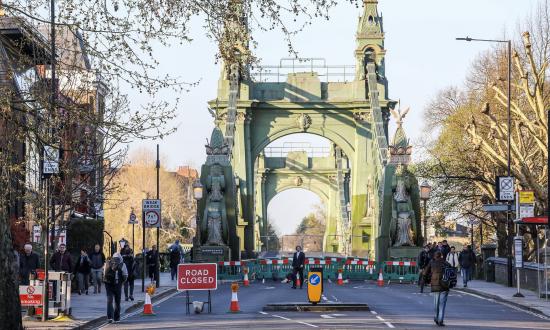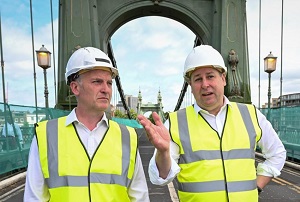H&F Council Confirms Bridge Repairs Could Take Up to Three Years
Work to begin after 'full diagnosis of potential problems and their causes'

H&F Council has confirmed that restoration of Hammersmith Bridge could take up to three years to complete.
The council says that a team of 18 world-class, specialist engineers are carrying out a full diagnosis of all the potential problems and their causes. Once that analysis is complete, the works to fully restore the Hammersmith Bridge will begin.
The council adds that the whole process could take up to three years before the works are finished and the bridge is re-opened to cars and buses.
The update comes after the Leader of Hammersmith & Fulham Council, Cllr Stephen Cowan was joined by Richmond Council Leader, Cllr Gareth Roberts on a tour of Hammersmith Bridge to view the refurbishment works being done to return the bridge to full working order and its former Victorian splendour.

Cllr Roberts, pictured left and Cllr Cowan, right, discussed how to work together to ensure that the needs of residents both north and south of the bridge remain the priority.
In 2015, H&F council and TfL agreed to restore the Grade II* listed 19th Century bridge to its former splendour and make it fit for modern public transport needs. That year, H&F Council also initiated the most comprehensive review of the bridge’s structural integrity ever seen.
In April 2019 that review’s weekly checks discovered micro-fractures in the cast iron pedestals securing the suspension bridge. The bridge was immediately closed to motor traffic for safety reasons.
Following their tour of the bridge, Cllr Stephen Cowan, Leader of the London Borough of Hammersmith & Fulham, said: "I’d like to thank Cllr Gareth Roberts for his constructive approach and for focussing on the needs of residents.
"People on both sides of the river want to see our beautiful Victorian bridge fully restored and operational for generations to come. That is exactly what is going to happen.
"But the works are complex as this 19th Century suspension bridge is unique. It’s made of cast iron which is brittle and uses wooden panelling. It was designed for nothing much heavier than horse-drawn carts and carriages but until recently was being used by 20,000 vehicles and 1,800 buses a day.
"That’s why in 2015, we curtailed the numbers of buses, initiated weekly monitoring and the most comprehensive review of the bridge’s structural integrity ever undertaken - which is how the micro-factures in the cast iron pedestals were discovered.
"We’re pushing to make sure Hammersmith Bridge will be re-opened as quickly as possible. And when it is, people will know that it’s benefitted from the most thorough refurbishment programme in its history which will keep it safe for decades."
Cllr Gareth Roberts, Leader of Richmond Council, said: " We know that Hammersmith Bridge has needed significant restoration work for decades. And, in an ideal world, we would have had a lot more time to plan and work with the community on a scheduled closure. However, the damage was a lot more severe than we once thought. And, the number one more important thing is that the bridge must be safe to all who use it.
“We will continue working with Hammersmith & Fulham Council and TfL on their plans for the future of the bridge and are committed to making sure that residents on our side are informed and importantly engaged, in any opportunity to help shape it’s future."
Last month, Transport for London announced the rejigging of local bus services due to the bridge closure. You can read the details here.
The bridge remains open to cyclists and pedestrians.

You can find background on the bridge and the works being done, including pictures of the cracks as above, plans of the bridge and a detailed FAQ, here.
June 4, 2019